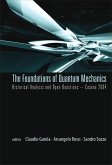- Gebundenes Buch
- Merkliste
- Auf die Merkliste
- Bewerten Bewerten
- Teilen
- Produkt teilen
- Produkterinnerung
- Produkterinnerung
Placing the development of quantum mechanics in its historical context, from its philosophical origins in Greece, to its scientific realisation in the 19th and 20th centuries, this textbook book culminates with an examination of the current state of the field and an introduction to quantum information and computing.
Andere Kunden interessierten sich auch für
![Foundations of Quantum Mechanics, Historical Analysis and Open Questions - Cesena 2004 Foundations of Quantum Mechanics, Historical Analysis and Open Questions - Cesena 2004]() Claudio Garola / Arcangelo Rossi / Sandro Sozzo (eds.)Foundations of Quantum Mechanics, Historical Analysis and Open Questions - Cesena 2004188,99 €
Claudio Garola / Arcangelo Rossi / Sandro Sozzo (eds.)Foundations of Quantum Mechanics, Historical Analysis and Open Questions - Cesena 2004188,99 €![Foundations of Quantum Mechanics in the Light of New Technology, Proceedings of the 7th Intl Symp (Isqm-Tokyo '01) Foundations of Quantum Mechanics in the Light of New Technology, Proceedings of the 7th Intl Symp (Isqm-Tokyo '01)]() Foundations of Quantum Mechanics in the Light of New Technology, Proceedings of the 7th Intl Symp (Isqm-Tokyo '01)140,99 €
Foundations of Quantum Mechanics in the Light of New Technology, Proceedings of the 7th Intl Symp (Isqm-Tokyo '01)140,99 €![Foundations of Quantum Mechanics in the Light of New Technology: Selected Papers from the Proceedings of the First Through Fourth International Symposia on Foundations of Quantum Mechanics Foundations of Quantum Mechanics in the Light of New Technology: Selected Papers from the Proceedings of the First Through Fourth International Symposia on Foundations of Quantum Mechanics]() Foundations of Quantum Mechanics in the Light of New Technology: Selected Papers from the Proceedings of the First Through Fourth International Symposia on Foundations of Quantum Mechanics160,99 €
Foundations of Quantum Mechanics in the Light of New Technology: Selected Papers from the Proceedings of the First Through Fourth International Symposia on Foundations of Quantum Mechanics160,99 €![Foundations of Quantum Mechanics in the Light of New Technology: Isqm-Tokyo '08 - Proceedings of the 9th International Symposium Foundations of Quantum Mechanics in the Light of New Technology: Isqm-Tokyo '08 - Proceedings of the 9th International Symposium]() Foundations of Quantum Mechanics in the Light of New Technology: Isqm-Tokyo '08 - Proceedings of the 9th International Symposium135,99 €
Foundations of Quantum Mechanics in the Light of New Technology: Isqm-Tokyo '08 - Proceedings of the 9th International Symposium135,99 €![Foundations of Quantum Mechanics in the Light of New Technology: Isqm-Tokyo '05 - Proceedings of the 8th International Symposium Foundations of Quantum Mechanics in the Light of New Technology: Isqm-Tokyo '05 - Proceedings of the 8th International Symposium]() Claudio Garola / Arcangelo Rossi / Sandro Sozzo (eds.)Foundations of Quantum Mechanics in the Light of New Technology: Isqm-Tokyo '05 - Proceedings of the 8th International Symposium188,99 €
Claudio Garola / Arcangelo Rossi / Sandro Sozzo (eds.)Foundations of Quantum Mechanics in the Light of New Technology: Isqm-Tokyo '05 - Proceedings of the 8th International Symposium188,99 €![Foundations of Quantum Mechanics Foundations of Quantum Mechanics]() Foundations of Quantum Mechanics132,99 €
Foundations of Quantum Mechanics132,99 €![The Structural Foundations of Quantum Gravity The Structural Foundations of Quantum Gravity]() Dean Rickles / Steven French / Juha T. Saatsi (eds.)The Structural Foundations of Quantum Gravity159,99 €
Dean Rickles / Steven French / Juha T. Saatsi (eds.)The Structural Foundations of Quantum Gravity159,99 €-
-
-
Placing the development of quantum mechanics in its historical context, from its philosophical origins in Greece, to its scientific realisation in the 19th and 20th centuries, this textbook book culminates with an examination of the current state of the field and an introduction to quantum information and computing.
Produktdetails
- Produktdetails
- Verlag: Oxford University Press
- Seitenzahl: 768
- Erscheinungstermin: 28. Mai 2023
- Englisch
- Abmessung: 248mm x 190mm x 40mm
- Gewicht: 1772g
- ISBN-13: 9780198822189
- ISBN-10: 0198822189
- Artikelnr.: 67735352
- Herstellerkennzeichnung
- Libri GmbH
- Europaallee 1
- 36244 Bad Hersfeld
- gpsr@libri.de
- Verlag: Oxford University Press
- Seitenzahl: 768
- Erscheinungstermin: 28. Mai 2023
- Englisch
- Abmessung: 248mm x 190mm x 40mm
- Gewicht: 1772g
- ISBN-13: 9780198822189
- ISBN-10: 0198822189
- Artikelnr.: 67735352
- Herstellerkennzeichnung
- Libri GmbH
- Europaallee 1
- 36244 Bad Hersfeld
- gpsr@libri.de
Robert Golub is a Professor of Physics at North Carolina State University. Steve Lamoreaux is a Professor of Physics at Yale University.
* PART I - BASIS OF THE THEORY
* 1: Introduction
* 2: Properties of the quantum world: indeterminacy, interference,
superposition, entanglement
* 3: The origin of quantum theory in the crisis of classical physics
* 4: Further steps to quantum mechanics: the old quantum mechanics of
Bohr and Sommerfeld
* 5: Further steps to quantum mechanics: Louis de Broglie and the
world's most important PhD thesis
* 6: The invention of quantum mechanics - matrix mechanics
* 7: Schrödinger and the development of wave mechanics
* 8: Further developments of wave mechanics by Schrödinger
* 9: Quantum statistics and the origin of wave mechanics
* 10: Early attempts at interpretation of the theory
* 11: The final synthesis of quantum mechanics: the 'transformation
theory' and Dirac notation
* 12: Dirac and Jordan commit 'sin squared': Second quantization and
the beginning of quantum field theory
* 13: The 'completion of quantum mechanics' - the fifth Solvay
Conference on Physics, October 1927
* 14: von Neumann's mathematical foundations of quantum mechanics:
Redux
* 15: Einstein and Schrödinger renew the assault on quantum mechanics
* 16: Weimar culture and quantum mechanics
* 17: Further development of the interpretation of quantum theory
* PART II - APPLICATIONS OF QUANTUM MECHANICS
* 18: Operator techniques and the algebraic solutions of problems
* 19: Spin-1/2 and two-level systems
* 20: Path integrals and scattering
* 21: Introduction to quantum computing (with the assistance of Edward
D. Davis)
* Free
* 1: Introduction
* 2: Properties of the quantum world: indeterminacy, interference,
superposition, entanglement
* 3: The origin of quantum theory in the crisis of classical physics
* 4: Further steps to quantum mechanics: the old quantum mechanics of
Bohr and Sommerfeld
* 5: Further steps to quantum mechanics: Louis de Broglie and the
world's most important PhD thesis
* 6: The invention of quantum mechanics - matrix mechanics
* 7: Schrödinger and the development of wave mechanics
* 8: Further developments of wave mechanics by Schrödinger
* 9: Quantum statistics and the origin of wave mechanics
* 10: Early attempts at interpretation of the theory
* 11: The final synthesis of quantum mechanics: the 'transformation
theory' and Dirac notation
* 12: Dirac and Jordan commit 'sin squared': Second quantization and
the beginning of quantum field theory
* 13: The 'completion of quantum mechanics' - the fifth Solvay
Conference on Physics, October 1927
* 14: von Neumann's mathematical foundations of quantum mechanics:
Redux
* 15: Einstein and Schrödinger renew the assault on quantum mechanics
* 16: Weimar culture and quantum mechanics
* 17: Further development of the interpretation of quantum theory
* PART II - APPLICATIONS OF QUANTUM MECHANICS
* 18: Operator techniques and the algebraic solutions of problems
* 19: Spin-1/2 and two-level systems
* 20: Path integrals and scattering
* 21: Introduction to quantum computing (with the assistance of Edward
D. Davis)
* Free
* PART I - BASIS OF THE THEORY
* 1: Introduction
* 2: Properties of the quantum world: indeterminacy, interference,
superposition, entanglement
* 3: The origin of quantum theory in the crisis of classical physics
* 4: Further steps to quantum mechanics: the old quantum mechanics of
Bohr and Sommerfeld
* 5: Further steps to quantum mechanics: Louis de Broglie and the
world's most important PhD thesis
* 6: The invention of quantum mechanics - matrix mechanics
* 7: Schrödinger and the development of wave mechanics
* 8: Further developments of wave mechanics by Schrödinger
* 9: Quantum statistics and the origin of wave mechanics
* 10: Early attempts at interpretation of the theory
* 11: The final synthesis of quantum mechanics: the 'transformation
theory' and Dirac notation
* 12: Dirac and Jordan commit 'sin squared': Second quantization and
the beginning of quantum field theory
* 13: The 'completion of quantum mechanics' - the fifth Solvay
Conference on Physics, October 1927
* 14: von Neumann's mathematical foundations of quantum mechanics:
Redux
* 15: Einstein and Schrödinger renew the assault on quantum mechanics
* 16: Weimar culture and quantum mechanics
* 17: Further development of the interpretation of quantum theory
* PART II - APPLICATIONS OF QUANTUM MECHANICS
* 18: Operator techniques and the algebraic solutions of problems
* 19: Spin-1/2 and two-level systems
* 20: Path integrals and scattering
* 21: Introduction to quantum computing (with the assistance of Edward
D. Davis)
* Free
* 1: Introduction
* 2: Properties of the quantum world: indeterminacy, interference,
superposition, entanglement
* 3: The origin of quantum theory in the crisis of classical physics
* 4: Further steps to quantum mechanics: the old quantum mechanics of
Bohr and Sommerfeld
* 5: Further steps to quantum mechanics: Louis de Broglie and the
world's most important PhD thesis
* 6: The invention of quantum mechanics - matrix mechanics
* 7: Schrödinger and the development of wave mechanics
* 8: Further developments of wave mechanics by Schrödinger
* 9: Quantum statistics and the origin of wave mechanics
* 10: Early attempts at interpretation of the theory
* 11: The final synthesis of quantum mechanics: the 'transformation
theory' and Dirac notation
* 12: Dirac and Jordan commit 'sin squared': Second quantization and
the beginning of quantum field theory
* 13: The 'completion of quantum mechanics' - the fifth Solvay
Conference on Physics, October 1927
* 14: von Neumann's mathematical foundations of quantum mechanics:
Redux
* 15: Einstein and Schrödinger renew the assault on quantum mechanics
* 16: Weimar culture and quantum mechanics
* 17: Further development of the interpretation of quantum theory
* PART II - APPLICATIONS OF QUANTUM MECHANICS
* 18: Operator techniques and the algebraic solutions of problems
* 19: Spin-1/2 and two-level systems
* 20: Path integrals and scattering
* 21: Introduction to quantum computing (with the assistance of Edward
D. Davis)
* Free








